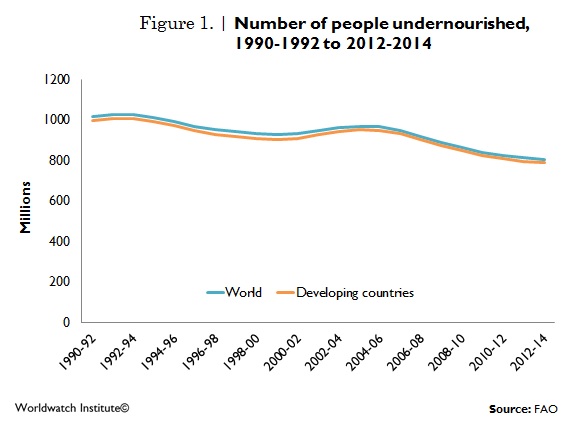
Agricultural News
Chronic Hunger Falling, But One in Nine People Still Affected
Tue, 02 Dec 2014 12:02:37 CST

Although the proportion of people experiencing chronic hunger is decreasing globally, one in nine individuals still does not get enough to eat, writes Gaelle Gourmelon, Communications and Marketing Manager at the Worldwatch Institute, in the latest Vital Signs Online article. The United Nations Food and Agriculture Organization estimates that 805 million people were living with undernourishment (chronic hunger) in 2012-14, down 209 million since 1990-92.
Undernourishment is defined as an inability to take in enough calories over at least one year to meet dietary energy requirements. It can lead to undernutrition, a broader term that describes a condition caused by a deficient or imbalanced diet or by poor absorption and biological use of nutrients within the body. Undernutrition can in turn lead to impaired physical functions and has high social and economic impacts. The combined cost of undernutrition and micronutrient deficiencies is equivalent to US$1.4-2.1 trillion per year, or 2-3 percent of gross world product.
Women and children are particularly vulnerable to nutritional deficiencies because of biological factors (such as pregnancy or rapid growth) and social inequities.Women's low educational levels, unequal social status, and limited decision-making power can influence both their own nutritional status and that of their children. Globally, undernutrition contributes to more than one third of child deaths.
Climate change presents an unprecedented challenge to nourishment through associated disruptions in supply chains, increases in market prices, decreases in assets and livelihood opportunities, reduced purchasing power, and threats to human health. The market sensitivity to climate change was highlighted recently by several periods of rapid increases in food prices following climate extremes-such as heat waves, droughts, floods, cyclones, and wildfires-in key producing regions. Food insecurity and the breakdown of food systems due to climate change disproportionately affect poorer populations.
Because poverty is the main determinant of hunger, access to food is determined by incomes, food prices, and the ability to get social support. Food prices have fluctuated greatly, although they generally have been rising since the late 1990s.
Food aid programs peaked in 2000-01. The 1999 Food Aid Convention (FAC), a multilateral donor cooperation treaty that aimed to contribute to world food security, saw a drastic drop in annual food aid shipments from 10.5 million wheat ton equivalents in 2000-01 to 5.7 million wheat ton equivalents in 2011-12. The Food Assistance Convention, which replaced the expired FAC in 2013, includes not only commodities (such as food and seeds) but also cash-based assistance. The impacts of the Food Assistance Convention remain to be seen.
The hunger target of the UN's Millennium Development Goal 1c (MDG-1c)-to halve the proportion of the population in developing countries who are hungry from the 1990 base year to the 2015 target year-is within reach. The prevalence of chronic hunger has fallen from 18.7 percent in 1990-92 to 11.3 percent in 2012-14, less than 2 percent above the MDG-1c target. The world is not on track to reach the more ambitious 1996 World Food Summit target, which aimed to reduce the actual number of hungry people to 412 million by 2015 (from a 1996 baseline of 824 million).
The fundamental human right to food, which is codified by the Universal Declaration of Human Rights, must be protected through social, economic, and political policies on food and health. Through investments, sound policymaking, strong legal frameworks, stakeholder involvement, and evidence-based decision making, the food security and nutrition environment can be improved to eradicate hunger worldwide.
Regional Highlights:
-- Latin America and the Caribbean has shown the greatest reduction in undernourishment, with the prevalence of chronic hunger falling by almost two thirds since the early 1990s.Economic growth, political stability, and agricultural and economic incentives have helped Latin America reach its hunger reduction target.
-- Sub-Saharan Africa has by far the highest prevalence of undernourishment of any region. While this share has declined from 33.3 percent in 1990-92, one in four people is still chronically hungry. High poverty rates, deteriorating rural infrastructure, and slow income growth contribute to ongoing low food availability and distributional access, resulting in the greatest food security challenge worldwide. Inadequate safe drinking water and sanitation facilities have limited people's ability to absorb and use the food that is available.
-- In 2014, certain areas of West Africa experienced restricted trade flows and market disruptions due to the Ebola virus outbreak. The effects of Ebola on food prices are not yet clear in Guinea, Liberia, and Sierra Leone, the most affected countries.
-- Because of Asia's large population, the region is home to two out of three of the world's undernourished (526 million people). In West Asia, political and economic instability, due mainly to conflicts in Iraq (where the proportion of chronically hungry surged from 7.9 percent in 1990-92 to 23.5 percent in 2012-14) and Syria, have contributed to an increase in the prevalence of hunger.
WebReadyTM Powered by WireReady® NSI
Top Agricultural News
More Headlines...



















